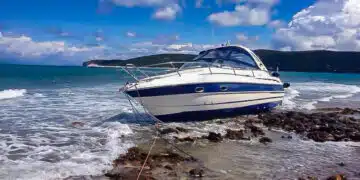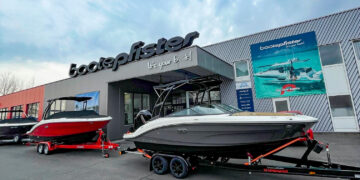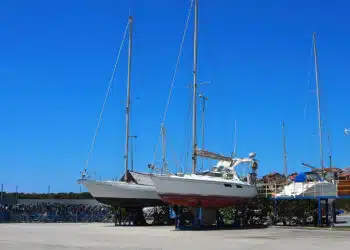Many larger yachts have jet skis on board, in addition to other water toys. Skippers are often unaware whether these need to be registered if they are taken on board the yacht as tenders.
Personal watercraft, known in English as personal watercraft (PWC), in Spain as moto de agua and in Italy as moto d’acqua, and marketed by Kawasaki under the now colloquial name jetski (or WaveRunner by Yamaha, Sea-Doo by Bombardier) are fun with their powerful water jet propulsion systems and are becoming increasingly popular with owners of larger yachts because of their maneuverability and safe handling.
However, there is uncertainty among many yacht owners as to whether they need to register the “small motorized watercraft made of GRP without a sideboard, on which you can sit like a motorcycle, and on which, by analogy, the steering is done via a handlebar” they carry, or whether, if necessary, an appropriate label is sufficient.
Any vehicle with more than three horsepower is considered a motorized small vehicle
First of all: any vehicle equipped with an engine with more than 3HP (2.21kW) power is considered a motorized small vehicle and is subject to mandatory marking. Also dinghies are subject to this regulation as motorized small craft in principle. This applies if the dinghy is at least also used for independent trips. In this case, a separate IBS and a separate license plate must be applied for, depending on the cruising area.
Only if the dinghy is used exclusively in its function as a dinghy (for example, for the transfer ashore or as a means of rescue), an attached reference to the mother ship (“tender to”) is sufficient. Concretely: abroad a tender is labeled with “tt” and name of the mother ship, for example “tt Princess” (is pronounced “tender to Princess”). By the way: “if the dinghy is used within sight of the main boat, it can also be included in the hull insurance,” recommends SeaHelp Insurance insurance expert Robert Perger.
If the dinghy is subject to registration, it must be registered (in Germany) with the Water and Shipping Authority, it will then receive an official license plate, which, however, is only valid within the federal territory. For those who want to use their boat additionally or exclusively abroad, a IBS makes sense. There are also regulations for proper affixing: the IBS license plate must be affixed to the outside of both sides of the bow or stern/mirror stern of the boat in ten centimeter high numbers/letters.
In case of doubt, jet skis should always be insured separately
In this case, by the way, the tender must be insured separately, as there is “no coverage outside the line of sight to the main boat,” says Robert Perger. In case of doubt, it is always better to insure jet skis and larger tenders separately because they are a separate vehicle, the insurance expert advises.
Generally applies: a boat may have several license plates, but only carry one license plate: either the IBS or the one issued by the WSA. However, because the IBS is “higher value” than the WSA designation due to its foreign validity, the IBS designation makes sense. An exception to this are the water motorcycles/Jetskis: these are to be provided with the official registration number (WSA) according to the German Water Motorcycle Ordinance.
The decisive factor is whether the dinghy is used as an independent small vehicle
Also for a CE Declaration of Conformity the above applies: as long as the boat is registered in the IBS exclusively as a dinghy, no separate CE declaration is required for it. Should the boat be used not only as a dinghy, but as an independent small vehicle, on the other hand, it requires its own IBS and thus also the corresponding CE declaration as well as its own insurance.













